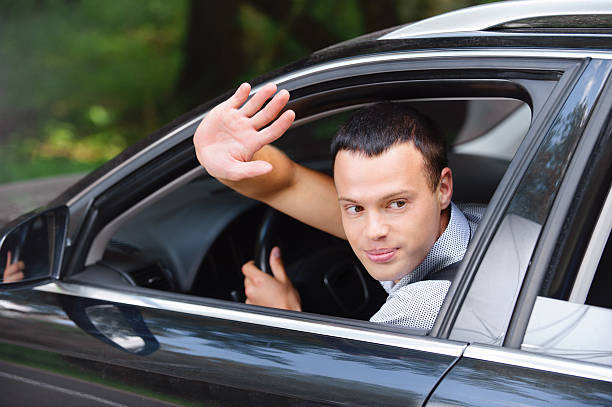Driving is more than just operating a vehicle—it’s about interacting with other road users in a respectful and safe manner. Good driving etiquette not only makes the roads safer but also fosters a more pleasant driving environment for everyone. At Get Drivers Ed, we believe that understanding and practicing proper driving etiquette is a key component of becoming a responsible driver. This guide will cover essential tips for being a polite and safe driver, helping you make the best impression on the road.
Why Driving Etiquette Matters
Driving etiquette involves the unwritten rules of polite behavior that every driver should follow. It encompasses everything from using turn signals to respecting other drivers' space. Practicing good driving etiquette can prevent road rage, reduce the risk of accidents, and make driving a more enjoyable experience for everyone.
Key Benefits of Good Driving Etiquette
Reduces Stress: A courteous driver is less likely to provoke negative reactions from others.
Enhances Safety: Proper etiquette can prevent dangerous situations and accidents.
Improves Traffic Flow: Polite drivers contribute to smoother and more efficient traffic movement.
1. Use Your Turn Signals
One of the most basic yet crucial aspects of driving etiquette is the use of turn signals. Signaling your intentions before changing lanes or turning helps other drivers anticipate your actions and adjust their driving accordingly. This simple gesture greatly enhances road safety and prevents misunderstandings.
Why Turn Signals Matter
Communication: Signals inform other drivers of your plans, reducing the chance of collisions.
Legal Requirement: Most states mandate the use of turn signals as part of their traffic laws.
Tip: Practice using your turn signals consistently in all driving situations to make it a natural habit.
2. Follow the Speed Limit
Adhering to speed limits is a fundamental aspect of both driving safety and etiquette. Speed limits are set to ensure safe driving conditions based on factors like road type, traffic density, and visibility. Driving too fast or too slow can be disruptive and dangerous for other road users.
Benefits of Following Speed Limits
Prevents Accidents: Driving within the speed limit reduces the likelihood of collisions.
Maintains Smooth Traffic Flow: Consistent speeds contribute to a more predictable driving environment.
Tip: Always adjust your speed according to road conditions, weather, and traffic flow.
3. Yield to Pedestrians
Pedestrians have the right of way at crosswalks, and it’s essential to respect this rule. Yielding to pedestrians ensures their safety and demonstrates courteous behavior. Always be vigilant and prepared to stop for pedestrians, especially in urban areas and near schools.
Why Yielding to Pedestrians Is Important
Safety: Protects vulnerable road users from harm.
Compliance: Meets legal requirements for pedestrian right-of-way.
Tip: Watch for pedestrian signals and always stop for pedestrians at crosswalks.
4. Avoid Aggressive Driving
Aggressive driving behaviors, such as tailgating, road rage, and weaving in and out of traffic, are not only dangerous but also inconsiderate. Maintaining a calm and composed demeanor on the road helps prevent conflicts and contributes to a safer driving environment.
Impact of Aggressive Driving
Increases Risk of Accidents: Aggressive maneuvers can lead to dangerous situations.
Creates Tension: Can provoke negative reactions and escalate conflicts.
Tip: Practice relaxation techniques and focus on staying calm, even in stressful driving situations.
5. Maintain a Safe Following Distance
Keeping a safe distance between your vehicle and the one ahead is crucial for safe driving. This distance gives you ample time to react to sudden stops or emergencies. Tailgating reduces your reaction time and increases the risk of rear-end collisions.
Benefits of Maintaining Distance
Improves Safety: Allows for adequate stopping time in case of sudden changes.
Reduces Stress: Provides more time to react to unexpected situations.
Tip: Use the “three-second rule” to ensure you’re maintaining a safe following distance.
6. Be Considerate at Intersections
Intersections are common points of conflict and confusion. Being considerate and following proper etiquette at intersections can prevent accidents and smooth out traffic flow. Always yield to traffic on your right if you’re entering an intersection without a stop sign or signal.
Tips for Intersection Etiquette
Wait for Your Turn: Don’t rush or try to beat other vehicles through an intersection.
Observe Traffic Signals: Follow signals and signs to ensure safe and efficient intersection navigation.
Tip: Be patient and cautious when navigating intersections, and always watch for pedestrians and cyclists.
7. Use Your Horn Sparingly
The horn is an important tool for warning others of immediate danger, but it should not be used excessively or aggressively. Misusing the horn can startle other drivers and escalate tension on the road.
Proper Use of the Horn
Emergency Situations: Use the horn to alert others to avoid potential accidents.
Avoid Frustration: Don’t use the horn to express anger or frustration with other drivers.
Tip: Reserve the horn for when it's truly needed to enhance safety.
Conclusion
Driving etiquette is a vital part of being a responsible and safe driver. By practicing the essential tips outlined in this guide—such as using turn signals, following speed limits, and yielding to pedestrians—you’ll contribute to a safer and more pleasant driving experience for everyone. Remember, good driving etiquette not only reflects well on you but also helps create a more harmonious driving environment.
Ready to enhance your driving skills and learn more about safe driving practices? Enroll in our drivers ed course at Get Drivers Ed and start your journey towards becoming a more polite and proficient driver today.

